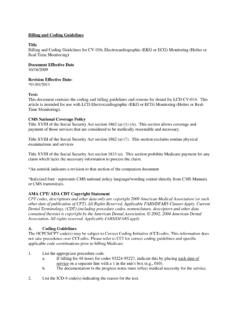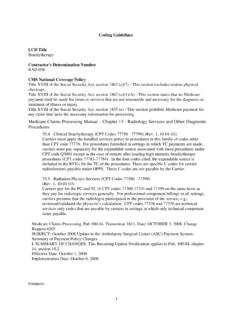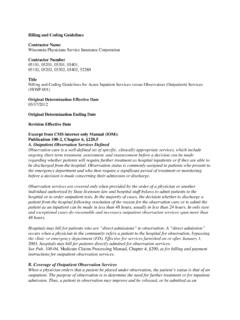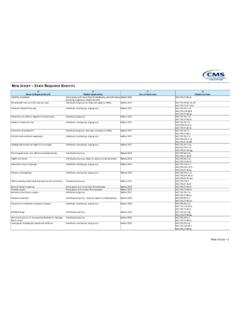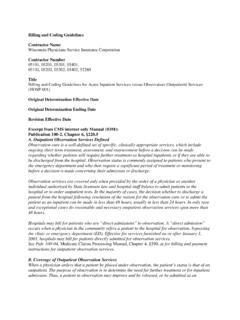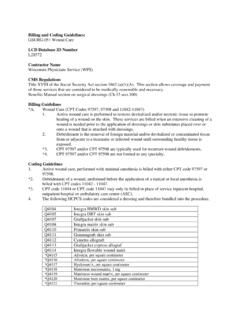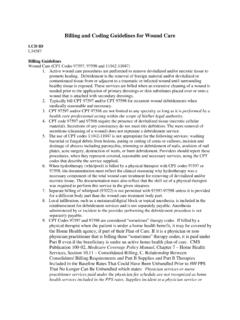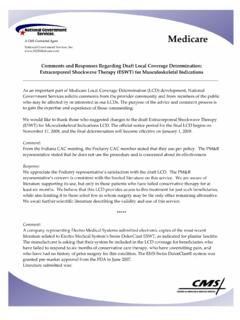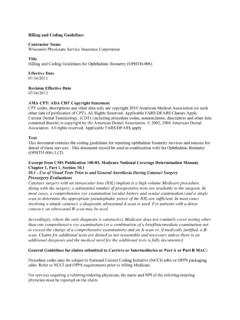Transcription of Billing/Coding Guidelines Article Title: Routine Foot Care ...
1 1 Billing/Coding Guidelines Article Title: Routine Foot Care And Debridement Of Nails Contractor's Determination Number FT-001 Article Effective Date 01/01/2010 Coverage Topic Foot care CMS National Coverage Policy Italicized Language is from Centers for Medicare and Medicaid Services (CMS). National Coverage Determinations (NCDs (42 CFR [b] and 42 CFR 426 [Subpart D Title XVIII of the Social Security Act Section 1862 (a) (1) (A) Section 1862 (a) (13)(C) Code of Federal Regulations (CFR) Part , subpart A CMS Publications: CMS Publication 100-2, Medicare Benefit Policy Manual, Chapter 15: 290 CMS Publication 100-3, Medicare National Coverage Determination Manual, Part 1: CMS Publication 100-9, Medicare Contractor Beneficiary and Provider Communications Manual, Chapter 5 Coding Information 1.))]
2 Report the appropriate procedure code and modifiers for the service(s) performed. a. When reporting foot/nail care report the applicable Q modifier. b. These services should be reported with quantity of one in the quantity/units field. 2. Report the ICD-9 code for which the service(s) is performed in the first position in the diagnosis field of the CMS 1500 claim form or electronic equivalent; report the systemic condition(s) in the remaining positions. Where the systemic condition is marked with an (*) (see below) and the services were rendered by a podiatrist, include the 8-digit (MM/DD/CCYY) date the patient was last seen and the NPI of his/her attending (MD/DO) physician who diagnosed the complicating condition in item 19 of the CMS 1500 claim form or electronic equivalent field, diabetes mellitus* Chronic Thrombophlebitis* peripheral neuropathies involving the feet - Associated with malnutrition and vitamin deficiency* Malnutrition (general, pellagra)
3 Alcoholism Malabsorption (celiac disease, tropical sprue) Pernicious anemia Associated with carcinoma* Associated with diabetes mellitus* Associated with drugs and toxins* Associated with multiple sclerosis* Associated with uremia (chronic renal disease)* 2 Hereditary sensory radicular neuropathy Angiokeratoma corporis diffusum (fabry's) Amyloid neuropathy Long term oral anticoagulant therapy ( Coumadin, Dicoumaral, etc.)* Services ordinarily considered Routine might also be covered if they are performed as a necessary and integral part of otherwise covered services, such as diagnosis and treatment of diabetic ulcers, wounds, and infections.
4 3. When billing for services, requested by the beneficiary for denial, that are statutorily excluded by Medicare ( Routine foot care), report an ICD-9 code that best describes the patients condition and the GY modifier (items or services statutorily excluded or does not meet the definition of any Medicare benefit) 4. When billing for services, requested by the beneficiary for denial, that would be considered not reasonable and necessary, report an ICD-9 code that best describes the patients condition and the GA modifier if an ABN signed by the beneficiary is on file or the GZ modifier (items or services expected to be denied as not reasonable) when there is no ABN for the service on file.
5 5. For patients on long term oral anticoagulant therapy, report the ICD-9 related to the performed service in the first position, the drug ICD-9 ( ) in the second position and the condition being treated with the anticoagulant in the third position of item 21 of the CMS 1500 claim form or electronic equivalent. 6. It is inappropriate and incorrect to report an E&M code when Routine foot care or a nail trimming/debridement service is the service actually performed. 7. The following class finding modifiers should usually be used with G0127, 11055, 11056, 11057, 11719, and when appropriate, CPT codes 11720, 11721.
6 A Class A finding (Modifier Q7) Two of the Class B findings (Modifier Q8); or One Class B and two Class C findings (Modifier Q9). 8. Benefits for Routine foot care are also available for patients with peripheral neuropathy involving the feet, but without the vascular impairment outlined in Class B findings. The neuropathy should be of such severity that care by a non-professional person would put the patient at risk. If the patient has evidence of neuropathy but no vascular impairment, the use of class findings modifiers is not necessary. This condition would be represented by the ICD-9 CM codes in list three of ICD-9 Codes that Support Medical Necessity listed in the LCD.
7 9. A diagnosis of onychomycosis can allow 11720 or 11721 if it has either a Q modifier (but does not need a MD or DO last seen) or if it has one of the 6 ICD-9 codes listed in the special section for onychomycosis, difficulty with walking ( , , , , , ). 3 Routine Foot Care Except as provided above, Routine foot care is excluded from coverage. Services that normally are considered Routine and not covered by Medicare include the following: The cutting or removal of corns and calluses; The trimming, cutting, clipping, or debriding of nails; and Other hygienic and preventive maintenance care, such as cleaning and soaking the feet, the use of skin creams to maintain skin tone of either ambulatory or bedfast patients, and any other service performed in the absence of localized illness, injury, or symptoms involving the foot.
8 Exceptions To Routine Foot Care Exclusion 1 - Necessary And Integral Part Of Otherwise Covered Services In certain circumstances, services ordinarily considered to be Routine may be covered if they are performed as a necessary and integral part of otherwise covered services, such as diagnosis and treatment of ulcers, wounds, or infections. 2 - Presence Of Systemic Condition The presence of a systemic condition such as metabolic, neurologic, or peripheral vascular disease may require scrupulous foot care by a professional that in the absence of such condition(s) would be considered Routine (and, therefore, excluded from coverage).
9 Accordingly, foot care that would otherwise be considered Routine may be covered when systemic condition(s) result in severe circulatory embarrassment or areas of diminished sensation in the individual s legs or feet. In these instances, certain foot care procedures that otherwise are considered Routine ( , cutting or removing corns and calluses, or trimming, cutting, clipping, or debriding nails) may pose a hazard when performed by a nonprofessional person on patients with such systemic conditions. Coding Information Date Last Seen by Attending Physician (for those ICD-9 CM codes which fall under the active care requirement): CPT codes 11055, 11056, 11057, 11719, and G0127 or 11720, 11721.
10 The approximate date when the beneficiary was last seen by the , , who diagnosed the complicating condition (attending physician) must be reported in an 8-digit (MM/DD/YYYY) format in Item 19 of the CMS-1500 claim form or the electronic equivalent or if the patient sees their primary care physician no later than 30 days after the services were furnished. For claims submitted to the fiscal intermediary: Hospital Inpatient Claims: The hospital should report the patient's principal diagnosis in Form Locator (FL) 67 of the UB-04. The principal diagnosis is the condition established after study to be chiefly responsible for this admission.
